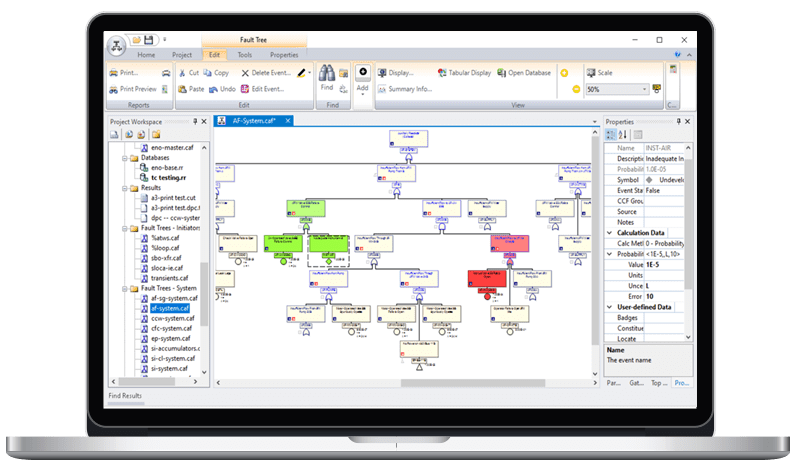CAFTA Technology Package V 11.1a - Phoenix Architect 2.1a
CAFTA is the industry leader in fault tree analysis for large, complicated, or multi-user collaborative projects. CAFTA allows you to build, quantify, and analyze fault tree models of any size or complexity.
CAFTA is flexible and adaptable, can import models from other COTS products, and run quantification engines supplied by third party vendors such as FTRex and program add-ins from 3rd party developers
CAFTA models provide a foundation for use with several other applications and specialist tools, such as fire, flood, and seismic risk analysis with FRANX, uncertainty analysis with UNCERT, and maintenance risk monitoring with Phoenix Risk Monitor

CAFTA users spend less time building models and more time interpreting results
CAFTA is a global product, widely used to address the complex needs of customers who design and operate the large engineered systems found in power generation, communications, transportation, aviation, and space applications. Its use has been instrumental in transforming the US nuclear power regulatory environment into one of "risk-informed regulation." The CAFTA products use EPRI technology.
CAFTA Benefits
Unique and powerful capability to build, review, and quantify big fault trees, upwards of >10k gates
Easy to use, from single analysts to project teams
User friendly tree browsing. Navigating tree logic is easy, in a continuous scroll from top to bottom, making it the most intuitive tree-browsing tool available
Includes powerful tools for complex model-management jobs: inserting common-cause failure (CCF) events, circular logic checks, checking for independence, pruning modules, quantification, and filtering cutsets
CAFTA Features
Four standard risk importance measures
Quantifies with both Direct Probability Calculation (DPC) and min-cut upper bound methods
Cutset post-processing with QRecover
Common-cause failure event modeling support with both Alpha factor and multiple-Greek letter methods
Software developers kit for adding CAFTA technology to other applications
Cutset filtering and side-by-side difference views
Project-level searching
Adjustable model-building environment with “pinnable” property panes.
Windows clipboard data exchange in multiple formats: fault tree logic, graphic images, tabular data.
CAFTA TECHNOLOGY PACKAGE Powerful Tools When You Need Them
PRAQuant Accident Sequence Quantification Tool
In performing a fault-tree based analysis it is often necessary to solve the fault tree several times, using different subtrees, boundary conditions, truncations or other assumptions about the model. These solutions can be performed manually in the CAFTA software, but it is often difficult to track and document the numerous results. PRAQuant is used to configure several fault tree analysis solutions in advance, and to track the completion and results from each run.
PRAQuant allows you to:
- Automate the accident sequence quantification process
- Employs the fault tree linking approach
- Work with other EPRI software components to complete the quantification process
DPC Direct Probability Calculator
DPC is a tool for calculating an exact top event probability (or frequency) of a fault tree logic model without employing cutset-based methods.
DPC allows you to:
- Calculate the exact probability of the gates in most fault trees
- Avoid problems inherent in quantifying fault tree via cutsets, including the rare-event approximation and the approximations associated with negated logic
- Estimates the exact top event probability of the fault tree by calculating lower and upper bounds—useful for large and complex fault trees, improving the speed of the calculation, while still obtaining useful results
- Use with frequency-based fault tree models to correctly calculate the frequency of the top event
UNCERT Uncertainty Evaluation Tool
UNCERT reads the cutset or sequence data created from CAFTA, and calculates the uncertainty of the cutset result.
UNCERT allows you to:
- Evaluate uncertainty of the top result for a given set of cutsets
- Calculate the uncertainty of various importance measures
- Report the result to other tools, applications or reports
ACUBE Advanced Cutset Upper Bound Estimator
The Advanced Cutset Upper Bound Estimator is used to calculate the probability or frequency of a Boolean function that is expressed by minimal cutsets. Minimal cutsets are typically developed and manipulated from a CAFTA fault tree model. Using ACUBE, a more accurate probability of a Boolean function and importance measures can be calculated. ACUBE is particularly useful in refining the results when the probabilities in the model violate the rare-event approximation.
FRANX Fire Modeling Tool
FRANX is a scenario-based Probabilistic Risk Analysis (PRA) Calculation tool. This allows you to define specific plant scenarios and calculate the risk of each scenario. Scenario-specific calculations appear commonly in the assessment of external event hazards, such as fires, floods, high winds, and seismic events.
SysImp Systems Importance Measures
The goal of SysImp is to support PRA applications that require collective risk importance measures.
SysImp allows you to:
- Reduce work effort by performing many time-consuming calculations unattended
- Perform calculations in a way that meets the same standard as the plant PRA. In particular, SysImp uses the same quantification engine as the PRA
- Provide a record of the calculations performed, so that the calculations may be reliably repeated or updated in the future
- Provide a user interface that makes it easy to visualize the results from large numbers of calculations
- Read any files that are readable by the EPRI Integrated Risk technologies software

